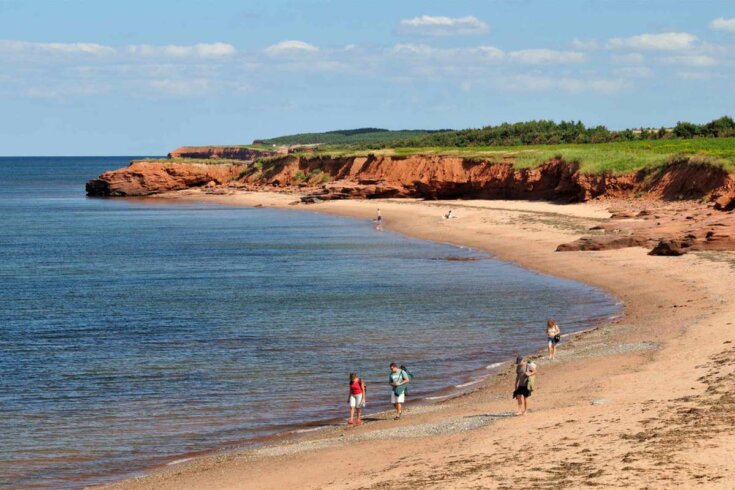On June 8—World Ocean Day—dozens of protesters gathered in front of the Prince Edward Island legislature, demanding to speak to Premier Dennis King. As the noontime rally got underway, local musician Allan Rankin’s tune “The Disappearing Island” piped in over a portable speaker. A group of Island women called the O Beautiful Gaia singers, committed to protecting the environment, joined their voices in harmony. The demonstrators were calling for an immediate moratorium on a controversial cottage development in an area called Point Deroche. “Talk with us,” event emcee James Rodd said, inviting the premier.
In September 2020, the PEI cabinet approved the sale of an oceanfront property of 17.5 acres to 251 Kelpie Lane Inc., later identified as a company owned by Jesse and Julia Rasch, a couple from Ontario. A clause in the province’s Lands Protection Act prohibits non-Island residents from owning more than five acres of land, but the cabinet can overrule the clause, which they did in this case. Soon, a massive summer home, comprised of four separate buildings, was approved for development on the site, located along one of the Island’s most iconic beaches. Locals say the development is an eyesore and imperils access to the beach at high tide. The situation has rankled scores of Islanders. For many of them, their history and identity have been shaped by contested land ownership, the meddling influence of outsiders, and a sacrosanct belief in their right to roam the Island’s beaches unimpeded.
In some ways, the protest was about much more than one cottage. PEI welcomes over 1.3 million visitors each year—about seven times the province’s population—and is home to a large number of seasonal residents from other parts of Canada and from the United States, many lured by the relatively inexpensive oceanfront properties. Scarce land, a booming population, and the existential threat posed by coastal erosion have exacerbated the locals’ mistrust of land ownership by perceived outsiders. The Point Deroche controversy is a harbinger of the land use conversations the province and the rest of the country need to sort out as climate change accelerates erosion and visibly blurs the line between public and private property.
Last December, a group of concerned Island citizens called the Coalition for the Protection of PEI Land—on whose behalf Rodd was speaking—forwarded a petition signed by over 2,500 people to King, demanding an immediate stop-work order on the construction at Point Deroche. For several months, the coalition had been requesting a meeting with the government to air their concerns about Point Deroche and other land transactions. According to Rodd, this outreach—along with subsequent emails and phone calls—was ignored, leading directly to the June rally. “We are here to insist that the premier and government listen to the voice of the PEI community,” Rodd said, to enthusiastic applause. “Who speaks for the land?”
Based in Ontario, the Rasch family runs a foundation investing in medical research, health education, and environmental stewardship. (The Raschs did not respond to a request for comment submitted through their website.) They’ve spent the past dozen years summering on the Island. The land they purchased on a relatively isolated stretch of the North Shore straddles a part of the province famous for white-sand beaches, vulnerable marshlands, and wild, windy weather. The former home on the property—known locally as the Old MacAndrew House—was a landmark for Island walkers, who travel the shoreline to walk their dogs or to beachcomb. The old property included remnants of a rudimentary and rotting seawall, built of creosote-treated timbers, constructed by previous owners in a fruitless attempt to stop erosion that has, by some measures, sucked nearly twenty metres of nearby land into the sea over the past forty years.
It didn’t take locals long to realize changes were afoot at the MacAndrew place. Trails advocate Bryson Guptill walks this beach frequently with his partner, Sue. Last summer, during a walk to Point Deroche, he and Sue noticed that the MacAndrew house was gone. In September 2022, during a subsequent visit, they came upon what appeared to be a giant pile of boulders dumped along the beach where the old seawall had stood. The rocks in fact marked the initial stages of an elaborate shoreline project undertaken by the Rasch family to protect or “armour” the ocean-facing property against erosion. At high tide, however, the rock pile blocked Bryson and Sue’s path across the beach, a fact later documented by images gathered by the CBC. While the old seawall had also obstructed beach access, the higher elevation of the new rock protection made the armouring appear more extreme. On September 11 last year, Guptill—a former policy adviser with the provincial and federal governments—posted a photo of this new armouring in a popular Facebook group he organizes for Island hiking enthusiasts.
His post galvanized Island residents, setting off a chain of competing claims and government backtracking still being sorted out today. Islanders have expressed their contempt in public forums, across social media, and in comments submitted as part of the coalition’s petition to the provincial government, including one that described the development as “an egregious attack on the historical right for people to have free access to the shore on PEI.” The harshest vitriol seemed reserved for the notion that non-residents had scooped up a cherished part of the Island for their own use. “The beaches are owned by everyone, not seasonal residents,” one comment reads.
Controversies around waterfront access have become more common in Canada in recent years, from lakefront squabbles in Ontario’s resort country to legislative fights over coastal erosion in Nova Scotia. In PEI, however, one expert says, the visceral nature of unease underlines a deeper fear. Laurie Brinklow, chair of the University of Prince Edward Island’s Institute of Island Studies, sees the Point Deroche situation in existential terms. For Brinklow, the connection many Islanders feel to the coastline is central to their sense of psychological well-being. Living on a small island creates a feeling of boundedness among island dwellers, of being held by the place where water and land meet. The edge of the coastline is sacred space, she says, and blocking access to that space constitutes a kind of psychic disruption. “It really hits to the heart of people’s sense of islandness and identity.”
Brinklow points out that, on smaller islands, space is always a contested issue because there’s such a minimal amount of land. “The smaller the scraps, the scrappier the fight,” she says. The land question has long been a thorny issue on PEI, going back to the eighteenth century, when the first European settlers in what would become PEI were beholden to wealthy absentee landlords who, between them, owned the entire land mass of the island and whose negligence created almost feudal conditions among local farmers. Of course, the entirety of the land that now comprises PEI—called Epekwitk in Mi’kmaw—was never legally ceded by the Mi’kmaq in the first place. Negotiations are currently underway for a proposed agreement that would see Epekwitnewaq Mi’kmaq and Parks Canada work as partners to co-manage the natural heritage places administered by Parks Canada on PEI, including protected shoreline not far from Point Deroche. And while a recent report on land use commissioned by the PEI government recommends offering the Mi’kmaq a substantive role in the development and shaping of land policies and land management in the province moving forward, the current debate at Point Deroche seems to largely exclude a Mi’kmaq perspective.
Three days after Guptill’s post last September, provincial officials issued a stop-work order, according to reporting by the CBC. Construction was halted after officials inspected the site and concluded that the location of the proposed structures did not meet the requirements set out in the province’s Planning Act. Soon, however, construction had resumed. In a statement to CBC News early in the spring, the province said the cease-construction letter was rescinded after provincial staff met the developer on site and “it was revealed that the building was in compliance with the application, provincial legislation, and information submitted.” A Nova Scotia environmental law firm engaged by Guptill disagrees, stating in a legal opinion that the development likely failed to meet provincial regulations, which stipulate that buildings must be set back nearly twenty-three metres from the shoreline. In this case, the development was approved based on plans showing the building only about fifteen metres from the shore—hence the original stop-work order by officials.
A few months later, the Rasch family created a website to address community backlash and to counter what they call misinformation being circulated about the project. While admiring the spirit of the campaign against their new summer home, they insist that all activity on the site is lawfully permitted and that their development in fact improves accessibility for beach walkers while contributing to the local economy. The website maintains that the new armouring is safer and easier to walk around than the old seawall. The owners also argue that the new home, compared to what had previously existed, is set back farther from the ocean.
Mike Kofahl, a lawyer with East Coast Environmental Law, the firm hired by Guptill for a legal opinion, says that most coastal land below the high-water mark—where the water hits at high tide—is Crown land, often provincial Crown land. And unless there are restrictions on the use or access of that provincial Crown land, members of the public have a right of access. The provincial government website also makes clear that, on PEI, a beach below the high-water mark is provincially owned and the public has a right to use it in most cases.
So what happens when a beach that was once easy to cross is now blocked at high tide due to the impacts of coastal erosion? How does the government reconcile its commitment to coastal protection and the legal requirement to maintain beach access with the rights of private property owners? Should the province have required the new owners to build farther back in order to guarantee beach access, given that erosion had brought the old house precariously close to the edge of the shore? Provincial officials did not respond to numerous requests for clarity around the situation at Point Deroche or answer questions about beach access. It seems the PEI government is still trying to untangle the knots.
At the June rally, Rodd invited the premier to belatedly accept his group’s petition. On his way into the legislature, King listened for several minutes while Rodd repeated the group’s demands. Would he extend the moratorium on the development at Point Deroche until a full investigation was undertaken to see if the spirit of the law was followed?
At last, King politely addressed the crowd. Over occasional cries from the audience—Follow the law! This thing needs to be done!—he spoke about his own connection to the Island. “I was born and bred in this province,” he said. “I hope to die and be buried here and I’m just going to try to make sure we leave it better for the next generation.” Before he left, he resolved to do everything he could to get to the heart of the matter.
A few weeks after the rally, an investigator with OmbudsPEI issued a letter to the Department of Environment, Energy and Climate Action, saying she was closing the file on a complaint made by Guptill about how provincial officials had handled the development. They concluded that the new seawall in fact is no taller than its predecessor and actually results in less of a footprint. In an email, Guptill told me the conclusion that the new seawall is smaller than the old wooden one is “ludicrous” and shows how government officials are trying to cherry-pick the facts to distort their rationale for approving the project. While Guptill is still hopeful the premier will reconsider the decision, he has not ruled out asking for a judicial review of the matter before the PEI Supreme Court.
For now, work on the property seems to continue. On a scorching day in early July, my partner and I hiked the beach from Blooming Point to Point Deroche. The tide was low, so we were able to skirt the shoreline between the grey boulders and the ocean. The armouring was in the process of being landscaped with the rich red Island soil. Staked into the sand at either end of the armouring were a pair of “Private Property” signs. A “No Trespassing” warning stood on the cliff. Meanwhile, looming high behind the stone hilltop—like a future fortress of reprieve from these troubled times—the foundation of the first new building slowly began to take shape.





